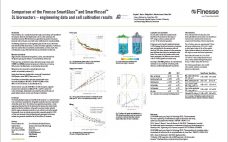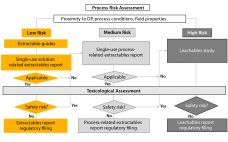FUJIFILM Diosynth Biotechnology (FDB) is a multifunctional commercial development manufacturing organization (CDMO) that manufactures virus-based therapeutics. Its site in Texas specializes in both adherent and suspension cell culture for production of virus vectors and for development of analytical assays to support production and expression of our clients’ therapeutics. We work with a number of cell lines such as human embryonic kidney (HEK293) and human retinal cells (Johnson & Johnson/Crucell’s proprietary PER.C6 line), which can grow in suspension. However, many of…
Sponsored Content
Development of a Next Generation Cellulose-Based High Capacity rProtein A Capture Resin for High Throughput MAb Purification in Both Batch and Continuous Purification Formats
A new product development approach will be described for the affinity capture of Mab’s from cell culture materials employing a novel base stable rProtein A ligand. Using a stable cellulose base bead with excellent flow properties coupled with a novel immobilization methodology, a next generation rProtein A capture resin has been developed with a high level of antibody binding capacity. The new Cellufine™ rProtein A resin shows C20% dynamic binding capacity (DBC) of >50 mg/ mL with polyclonal antibodies at…
Long-Term Reliability of an Aseptic On-line Glucose Monitoring and Control System for Perfusion CHO Cell Culture
Among the variables that are appropriate for direct feedback control of the perfusion rate in mammalian cell cultures, high priority should be given to the glucose concentration. Here we describe the application of a closed-loop control scheme for the long-term cultivation of CHO cells in a high cell density (35 – 40 million cells/ml) perfusion process. The monitoring and control system worked successfully for 2.5 months without any signs of performance degradation. In targeting industrial applications, issues such as reliability,…
Beta Cyclodextrin Derivatives as Protein Aggregation Modulators
Protein aggregation is the major challenge encountered during manufacturing, storage and transportation of biopharmaceuticals (1,2). The objective was to evaluate the effect of two ßcyclodextrins derivatives: (KLEPTOSE® HPB hydroxypropyl-ß-cyclodextrin, with MS=0.65) and (KLEPTOSE® HP hydroxypropyl-ß-cyclodextrin, with MS=0.9) on two biologic drugs (Infliximab and Etanercept) aggregation using high-throughput formulation screening (iFormulate™) and nanoDSF (Differential Scanning Fluorimetry) (3,4). Preliminary results demonstrate that KLEPTOSE® HPB BioPharma hydroxypropyl-ß-cyclodextrin and KLEPTOSE® HP BioPharma hydroxypropyl-ß-cyclodextrin at high molarity (200 mM) are efficient tools in modulating Infliximab…
Novel Single-Use Systems Allow Faster Powder Transfer and Higher Recovery Rates (Poster)
Single use powder containment practices are still in their infancy but keeping your product from cross contamination and reducing airborne particulates is important. Understanding how more modern bag designs can increase safety and speed is a concern to the industry. We looked at the ease of fill along with dispensing times and product loss. ILC Dover’s EZ-Biopac shows a 71% decrease in filling times when measured against an industry standard 2D bag. Due to the non-static film we saw an…
Immuno-Oncology Therapies: In Vitro Functional Assays for Drug Selection and Development
The immune system is at the center of a new era in effective strategies to treat cancer leading to significant growth in the immunooncology sector, and the development of competing technologies to further improve patient survival rates. Essential to the successful development of cancer immunotherapeutics are ex vivo and in vitro assays to: Confirm mode of action Compare activity with competitors Identify lead candidates Evaluate and select combinations At Abzena, we have developed a suite of assays to confirm and…
Comparison of the Finesse SmartGlass™ and SmartVessel™ 3L Bioreactors: Engineering Data and Cell Cultivation Results
Finesse Solutions Inc. recently introduced the single-use benchtop scale SmartVessel 3L bioreactor, which was developed based on its re-usable counterpart, the SmartGlass bioreactor. With identical main geometrical parameters, the plastic bioreactor mimics the glass vessel with minor modifications for manufacturability. The following study focuses on the engineering data of both vessels, which have been determined with special focus on animal cell culture applications. Furthermore, data from material tests on leachables and extractables as well as results from cell cultivations using…
Control of Single-Use System Supply Chains
Single-use technologies are now dominant for the clinical production of biopharmaceuticals and are becoming more mainstream within commercial manufacturing facilities. They allow biologics manufacturers to decrease the footprint of their facilities by approximately 20% because of a reduced need for utilities that generate water, steam, and clean-in-place solutions. Engineers believe that the capital outlay for a single-use facility is 25–45% less than for a facility based on stainless steel equipment. Similarly, they estimate that such facilities need half the water…
Exploring the Science Behind Single-Use Container–Closure Integrity Assurance
Failures in the integrity of single-use systems during commercial manufacturing can cause a number of serious problems for biomanufacturers. A loss of system integrity during processing can allow environmental contaminants that can be dangerous for patients (e.g., microbes) to enter a process. Biopharmaceuticals and their intermediates can be highly potent or even infectious agents, so an integrity failure can jeopardize the safety of operators. In severe cases when biomanufacturers cannot ensure the quality of drug products for fear of a…
Single-Use Production Platforms for Biomanufacturing
The pipeline of biopharmaceuticals remains strong, and the market for biologics could exceed US$450 billion by 2025. Analysts predict that sales within segments such as regenerative medicine and antibody–drug conjugates (ADCs) will grow faster than 20% each year. Yet considerable challenges remain for biopharmaceutical companies to overcome if they wish to be successful. First, they must reach the market quickly. Analysis by the Boston Consulting Group shows that the proportion of available value that a newly launched product can capture…










